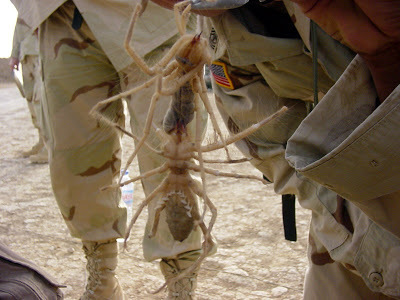Hobo Spiders, Part 2 of 4
 Camel Spiders
Camel Spiders(The Book of Deadly Animals hits the US later this month. As with the recent UK release of the book, I'm going to celebrate by running here an expanded version of a story from the book.)
It's hard to say how many people have been hurt by hobospiders, because spider bites are remarkably difficult to diagnose. Part of theproblem is that they often don't hurt enough at first to draw any notice. Evenin the case of bites that develop serious symptoms like the ones I describedabove, it is unusual for the victim to bring in the guilty spider. Often thesupposed spider bite is just a wound or sore of unknown origin. It's beenestimated that 80% of the so-called spider bites physicians treat are reallysomething else entirely—the bites of lice, fleas, or ticks; the symptoms ofdiseases like Lyme disease and tularemia; strep or staph infections developingaround minor scratches. Even eczema or a too-vigorously scratched mosquito bitemay cast aspersions on some innocent arachnid. When several Americans came downwith skin lesions in 2001, symptoms eventually attributed to anthrax spread byterrorists, doctors first suspected brown recluse spiders.
Why do spiders so often get the blame? Part of the answerseems to lie in arachnophobia. People who notice a sore and, separately, aspider in the house may jump to the wrong conclusion. Serious arachnophobesoften report the feeling, which they themselves may recognize as irrational,that spiders are malicious, trying to frighten and harm human victims. Evenpeople without a full-blown phobia will sometimes fall into this way ofthinking. In fact, most spiders, if they're capable of biting people at all,only bite in defense of self, eggs, or territory, but many people aren't awareof, or even interested in, that fact.
Another source of confusion is folklore. Stories of venomousarthropods circulate so frequently that scientists tend to dismiss them out ofhand. Around 2001, I received emails warning of "blush spiders," tinybut deadly red spiders that hide under the seats of toilets on airplanes readyto bite the unwary traveler on his or her most sensitive parts. There'sactually no such thing as a blush spider. Its "scientific name," Arachnius gluteus, which would seem totranslate into something like "butt spider," is an easy tip-off.
In 2004, I received anxious queries about "camelspiders," accompanied by a shocking photo of a massively-fanged monster aslong as a man's leg. The camel spider, it was said, habitually runs along undercamels, leaping up to feast on the flesh of their bellies. Its venom was saidto dissolve flesh rapidly. It was claimed that these creatures represented adeadly menace to soldiers at war in Iraq. In fact, camel spiders are harmless,though scary-looking. They are known variously as sunspiders and windscorpions,but are really a little-known arachnid family unto themselves, the solfugids.The largest solfugids in the world are about the size of a woman's hand, whichis certainly awe-inspiring, but a mere fraction as large as the trick ofperspective in the well-circulated internet photo suggests. Solfugids don'tbite people—their mouthparts aren't hinged the right way, so it's the nextthing to physically impossible—and they don't pack toxin. Since their fangs areso massive for their size (proportionally the largest in the animal kingdom), theyrely on mechanical injury to kill their prey, not venom.
These are only two examples of the folkloric nonsense aboutarachnids constantly in circulation. Another bit, from the Middle Ages, heldthat spiders spread the Black Death that killed a third of the population ofEurope. It's been suggested that this myth underlies the arachnophobia soprevalent in Western culture.
With such drivel perpetually in the air, it's not surprisingthat many scientists and doctors have dismissed more credible claims out ofhand.
Next: Shaved Rabbits
Published on January 11, 2012 09:00
No comments have been added yet.



